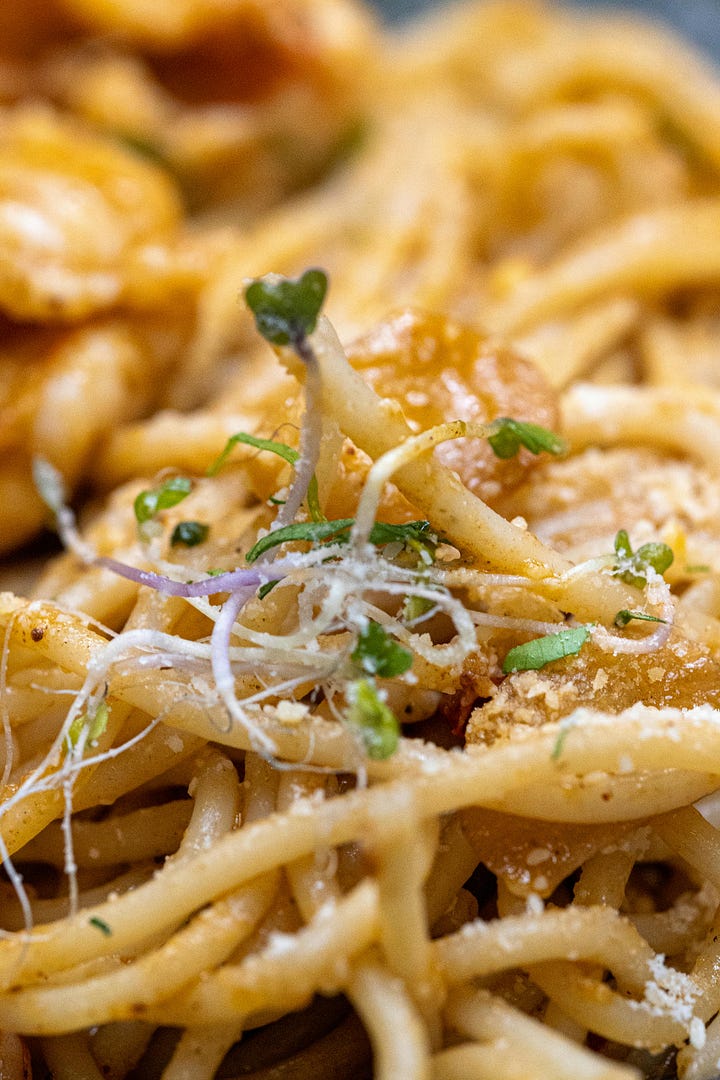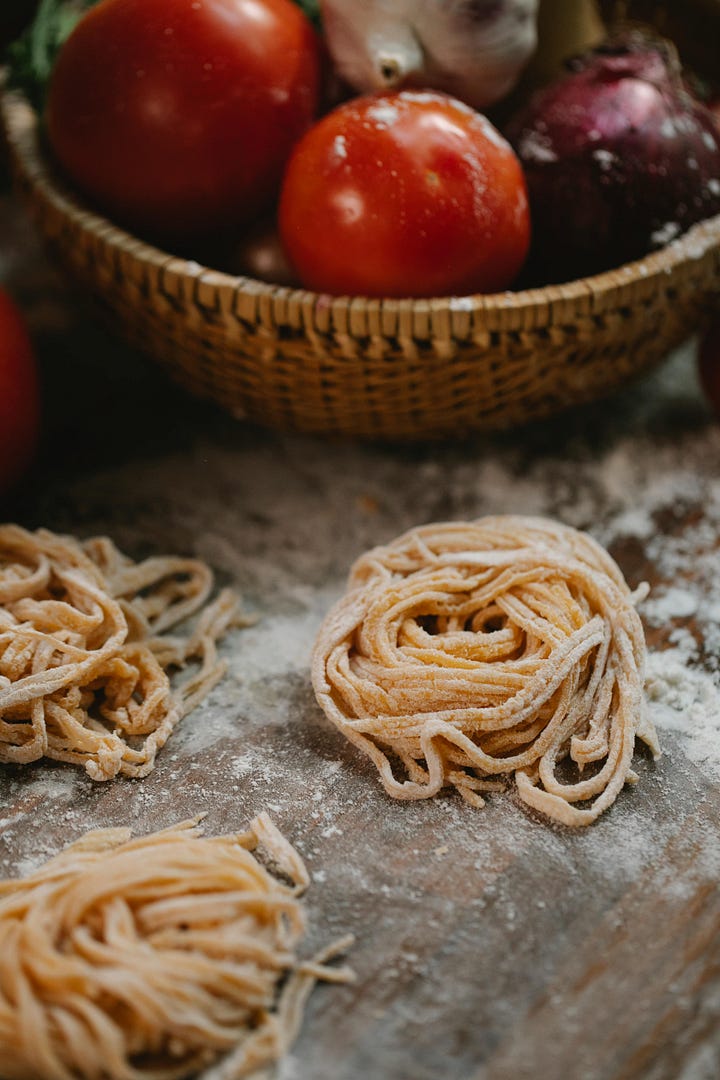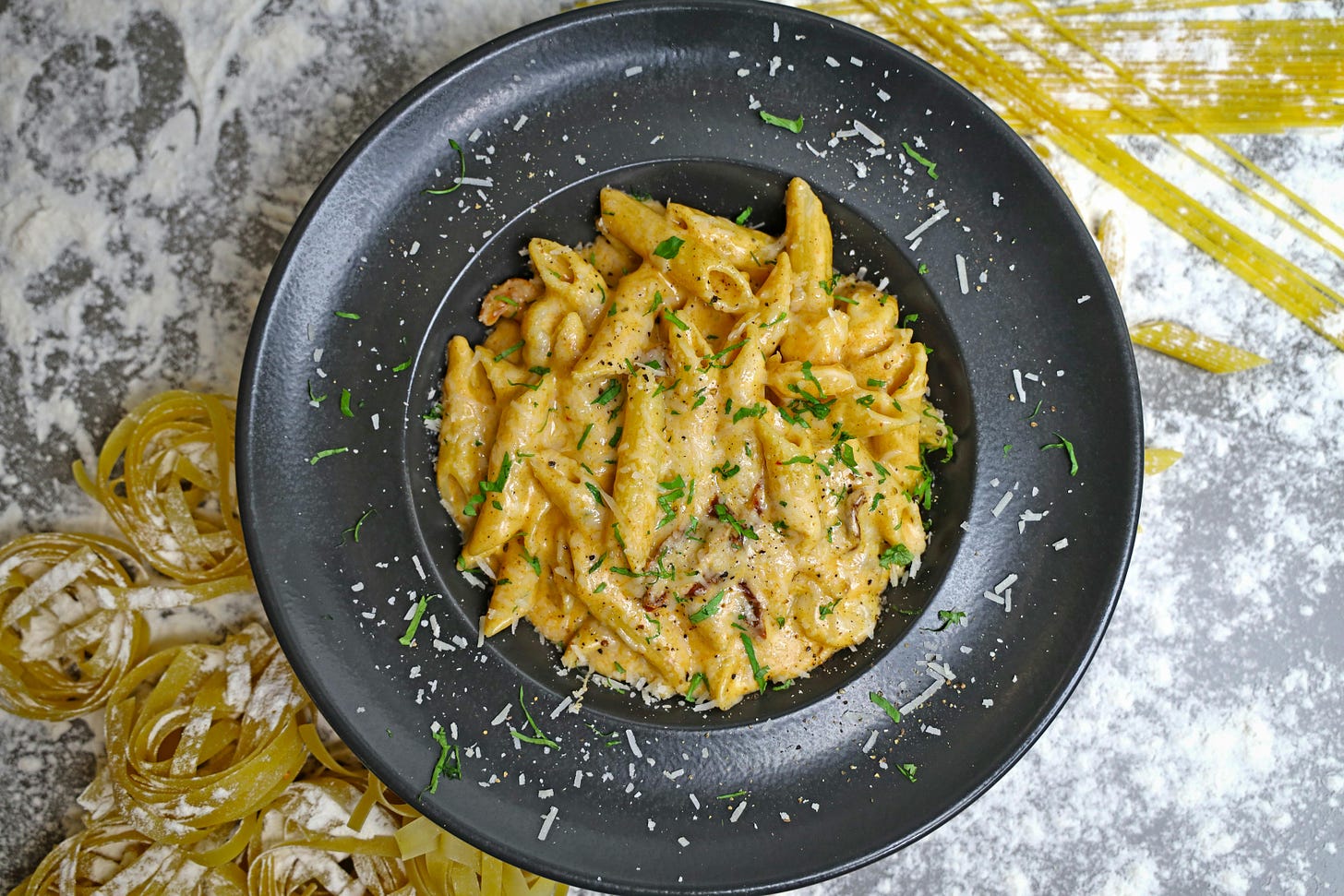My Favorite Pasta Shapes & the Dishes that Use them
Pasta: 4 Ingredients, 300 Shapes
This morning my parents said something wonderful to me about tonight’s dinner: ”Let’s just have pasta.” I never say no to a pasta night. Born out of the proverbial cucina povera in Italy, the dish lives rent-free in my kitchen at all times. For generations, delicious homemade Italian pasta has been made with only a few ingredients: semolina flour, eggs, salt, and olive oil.
Although only four simple ingredients are needed to make the dough, there are over 300 varieties of pasta with unique shapes. Penne, farfalle, rigatoni, bucatini, orecchiette, gnocchi, and tortellini, are just a few of the hundreds of types in existence.
Living in Rome for two years, I ate a lot of pasta. And when I say a lot I mean a lot. I had it at least once a day and no, I never got tired of it. Pasta for me is soul food. Comfort food. And frankly, with all of the different recipes in existence, regional distinctions, and styles, I never got bored. One major takeaway was that I developed a preference for certain shapes.
The size, shape, and surface texture of the pasta directly complements a variety of factors: pasta-to-sauce ratio, sauce adherence and compatibility, cooking time, and overall taste. The last one tends to inform our preferences (I'm a penne and spaghetti girl myself and farfalle is persona non grata in my kitchen, so to speak). Once you try a range of different dishes you'll start to form your preferences and, most importantly, when to use each particular type of shape depending on the recipe.
PENNE Rigate
Perhaps one of the most popular pasta shapes, penne pasta has come to be known as old reliable in many kitchens. While born in Genoa, this two-inch long, short pasta comes in two main varieties in Italy: penne lisce (smooth) and penne rigate (textured, ridged), the latter having ridges or stripes that run along the sides of the pasta. Known simply as penne, penne rigate is the star of the show, and the one you'll come across the most. And, I have to say, it’s my favorite as the five boxes in my kitchen closet attest.
With its cylindrical shape (the word "penne" comes from the Latin word, penna meaning "feather" or "quill"), hollow center, angled edges, and ridged texture, penne rigate is truly versatile! Not to mention a fantastic sauce-scooper, able to pick up as much juicy rich sauce as possible so that each forkful never goes to waste. It's particularly adaptable to most sauces, light, creamy, heavy, and everything in between.
While you may find it paired with marinara or pesto, my favorite saucy dish that utilizes this pasta shape is none other than penne all'arabbiata. This spicy tomato confection includes garlic, basil, and hot chili pepper. Meaning "angry" in Italian, this was probably my first meal when I arrived in Rome. A specialty of the Lazio Region and the Eternal City, it quickly became my favorite and I ordered it anytime I saw it on the menu. Although it’s described as spicy, my spice tolerance is pretty high, so the dish was just pleasant and flavorful.
GEMMELI
For the love of under-appreciated pasta shapes, let's talk about gemelli. Italian for "twins," this short, braided pasta is easily recognizable for its corkscrew-twisted shape. Like other short pasta cuts, gemelli is versatile and compatible with a range of light to moderately thick sauces.
This aesthetically pleasing pasta is used in a variety of dishes, from baked dishes like casserole to cold tomato, basil, and mozzarella salads. When I run out of penne, usually there's a box of gemelli in the back, waiting to be claimed. While this pasta shape isn't as famous as its siblings, it's a truly satisfying shape to eat, and one of very few that can alternate between entrées and side dishes.
SPAGHETTI


If there is one pasta shape that needs no introduction it's spaghetti. Known as the quintessential pasta type, spaghetti is said to have been introduced to Sicily by Arab conquerors in the 8th century CE (Encyclopedia Britannica: "Spaghetti"). Fast-forward a couple of centuries and spaghetti continues to be the most widely-used and beloved pasta shape.
Spaghetti, Italian for "little chords," is recognizable for its long, thin, and rounded shape. When it comes to my favorite pasta shapes, spaghetti comes in at a close second, for its quick cooking time, texture, and versatility.
Spaghetti can be used for most pasta dishes, making it an easy go-to for meals. While its thickness varies by Italian region, classic spaghetti is on the thinner side and is the ideal cut for lighter sauces. Notably, these include sauces with an oil or tomato base such as two of my favorite pasta dishes: cacio e pepe and spaghetti aglio e olio.
Cacio e pepe, Italian for "cheese and pepper" is a recipe for the "less is more" crowd. Traditionally made with tangy aged pecorino-romano cheese, zesty black pepper, and spaghetti, this creamy dish is Roman in origin. Spaghetti aglio e olio is a simple and delicious Neapolitan pasta dish that sautés spaghetti, olive oil, and thinly sliced pieces of garlic together.
BUCATINI
Spaghetti's thicker, juicier cousin, bucatini is perfect for those who love heavy, rich sauces. Italian for "hole," bucatini, while spaghetti-like, has a hole or tunnel running through the center. This gives it a chewy texture, making it the perfect choice for scooping up lots of cheese and sauce. Although I'm not partial to thick cuts of pasta, bucatini is incredibly filling and stars in one of my oft-made pasta dishes at home: bucatini all'amatriciana.
This dish contains amatriciana sauce, a light tomato-based sauce, with pieces of guanciale (cured pork cheek), red pepper flakes, black pepper, and pecorino cheese. Full of flavor and zest, bucatini does a marvelous job of carrying each forkful to your mouth.
GNOCCHI
Although its pronunciation may be difficult, eating it is not. Gnocchi has many, many uses and variations. It can be made out of "...flour, semolina, potatoes, or sweet potatoes, boiled or baked, and served with butter and grated Parmesan cheese or a savory sauce.” Traditionally rolled into little balls or ovals, gnocchi are similar to dumplings in shape.
They can be fried, baked, and even stuffed. I will never forget the first time I had a creamy dish of cheese-filled potato gnocchi with pancetta (*chef's kiss*). These potato dumplings have been a staple of Italian cuisine since the early 19th century, and continue to be one of the most sought-after pasta dishes in the world. It’s easy to see why, and frankly, it will forever remain in my top 5.








